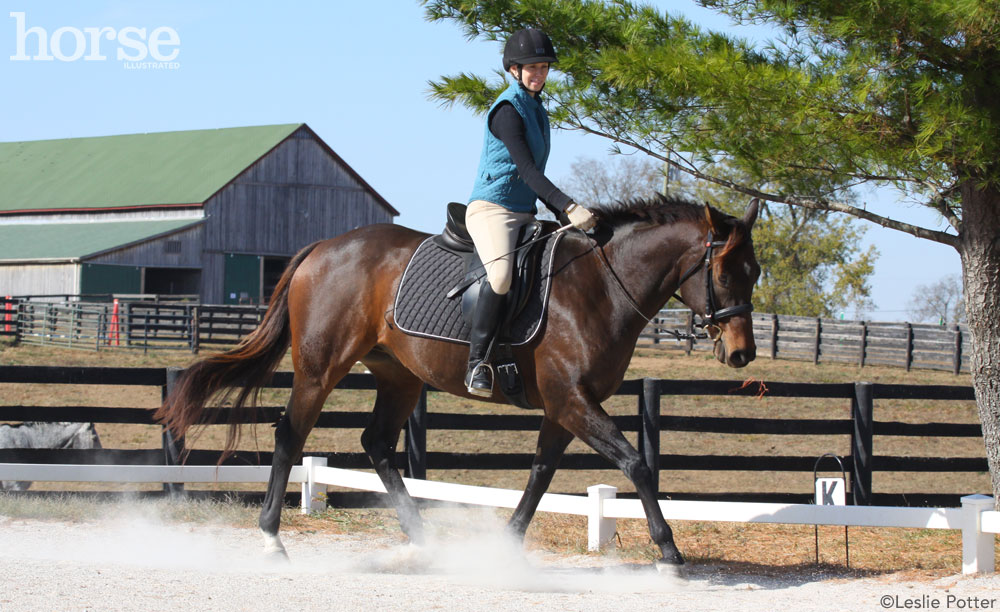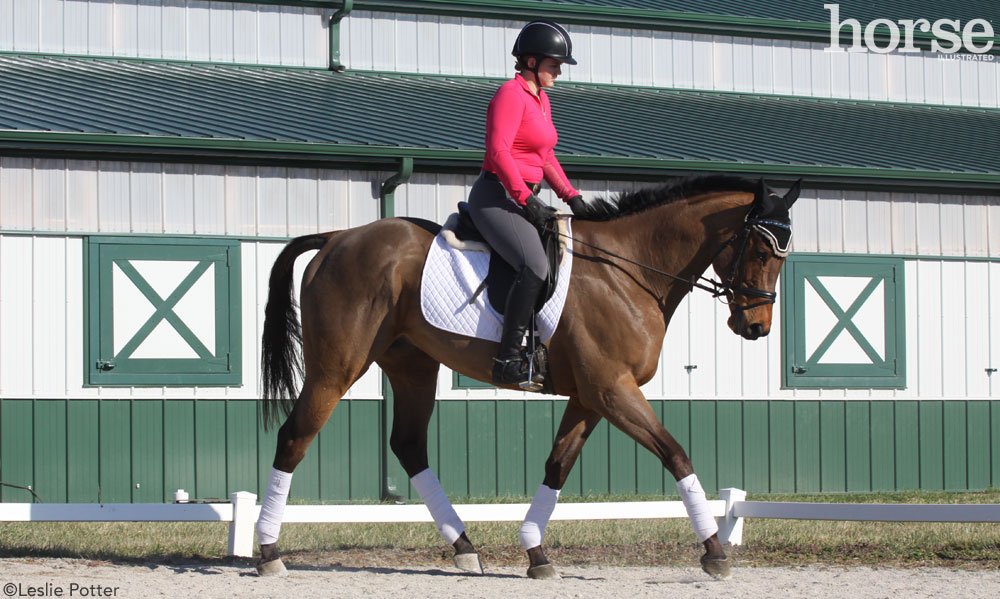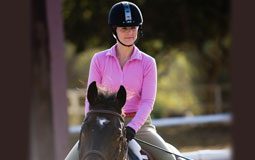Riding in an arena would be a lot easier if, once the aids had been given for the required gait, the horse simply responded by keeping one eye on the fence and merrily found his own way around. But while many people ride on the rail thinking the horse can almost do it by himself, their corners are probably a disaster. To prove it, pick any corner in a fenced arena and look at the hoofprints in the sand. It’s a fair bet that the arc worn into the track will be a fairly wide one that starts and ends well short of the actual corner. Technically, that’s incorrect. The horse should go deeply into each corner so the arc is a relatively small one.

To most riders, riding corners properly is completely uninspiring and of little or no importance. But that’s a dangerous notion, especially for dressage competitors. Well-ridden corners can be a valuable source of extra marks—perhaps making the difference between winning a ribbon and going home empty-handed. Even better, they can also provide extra space to work in and allow more thinking time during the test. For example, let’s assume that a halt is required at the C marker on the short side of the arena, and the horse is working on the right rein (going clockwise). If the corner after H is ridden in a wide arc, there will only be a few straight strides before C is reached. That means there will be less time to prepare the horse for a square halt.
However, if the corner after the H marker is ridden deeply, the tighter turn will allow a few more strides on the approach to C. Extra space has been created to get the horse straight, which also leads to a little more thinking time to prepare for the halt. That’s quite an advantage, but it’s not the only one. Riding deeply into the corners adds to the overall presence of the test, and proves that the horse is balanced and supple.
Getting Started
Anyone with basic riding skills can easily improve his or her cornering technique. If the horse is fit and can perform a balanced trot on circles of less than 20 meters in diameter, accurate corners can usually be achieved within a few weeks.
The ideal time to start is during the next schooling session. Warm your horse up for several minutes, and then ride around the arena on the rail, taking the same line on the corners as usual. After a round or two, move to the inside of your track and look at the hoofprints around the corners. Ask yourself these questions: “Is the arc too wide? Could I have kept to the rail a little longer on the approach to the corner and made a tighter turn?” If the answer to both is yes, then there’s room for improvement. Take your horse back onto the track, pick a corner and plan to ride it a couple of strides deeper than last time before making the actual turn. Do it at the walk initially to give yourself extra time to think about what you’re doing and choose the correct line for the curve.
There’s one important point that must not be overlooked at this early stage. Never go so far into the corner that the only way to complete the turn is by making a desperate haul with the reins. That defeats the objective and is bad riding. The turn must always be comfortable for the horse and in proportion to his size and current level of athletic ability.
When you analyze it, riding a corner is really nothing more than making a quarter turn, and the aids for turning are one of the first things we learn asbeginners. Assuming the horse is tracking right, the rider’s inside (right) hand controls the bend and direction, and the inside leg applied near the girth keeps the forward impulsion. The outside (left) hand controls the pace and balance, and the corresponding leg, when lightly applied behind the girth, stops the hindquarters from swinging out.
Assuming there was little problem in riding a deeper corner at the walk, most schooling can be done at the trot. A sitting trot may be preferable to posting during the first few attempts, as a more stable position can help both horse and rider. Don’t start the exercise until the horse is trotting actively and really using himself, which doesn’t mean trotting fast. When the pace is relaxed and steady, aim to do one complete pass around the arena riding all four corners a few strides deeper than normal.

Mental Cues
One vital ingredient to success is the rider’s mind. Try thinking “turn” rather than “corner” or “arc.” When the last stride has been reached on the straight, say to yourself, “and turn,” as if mentally turning 90 degrees. Imagine that your hips and pelvis are actually steering the horse rather than the legs and hands. This can have a very positive effect on some horses, and it is equally useful for changes of direction other than in arena corners.
It may also be helpful to think of the inside leg as the pivot around which the horse will be turned. To reinforce this, a firm push with the outside leg at the girth when making the turn can help achieve a fluid movement. You can really feel that the horse is turning around that inside leg.
Although this may not be the textbook way of doing things, many horses respond favorably to it. Once the desired result has been achieved, however, riders may prefer to go back to the standard methods.
Halfway down the long side of the arena, or at the B or E markers, if they are in place, look straight ahead to the next corner. The horse should be going straight with sufficient impulsion to make the turn. On the first corner, aim to follow the tighter line as previously ridden at the walk. Remember to use the inside leg to keep the forward movement, think “turn,” and don’t be too heavy with the inside rein when asking the horse to bend.
Once around, the next corner will loom up fast. Ride it exactly the same, and then follow on down the next long side and ride the other two corners. With one round completed, there’s usually a great feeling of satisfaction as most horses can handle the additional couple of strides without too much difficulty.
But what if it wasn’t that easy, and the horse found the turns difficult? In that case, the animal may be a novice, unfit, stiff on one side (as most horses are) or in extreme cases there may be some physical condition that needs professional attention. The horse may also have been a victim of what I term the “railroad factor.” In arenas that are heavily used—like at riding academies and boarding stables — a definite groove often gets worn into the track where numerous horses have gone round on the rail. This deep indentation is unlikely to have accurate corners, as most riders are prone to cutting them.
Horses love to use this well-trampled groove like a locomotive on a railroad track. They go where it goes. Sometimes it’s difficult to avoid this on the straight due to space restrictions, but never let it ruin the corners. Obviously, the horse may have to step out of the groove for a few strides when the corner needs to be tighter, and some of them just hate losing their well-worn guide. The answer is to ride assertively with firm leg aids and give a light tap with a schooling whip if the horse slows or seems hesitant to step out of it.
Staying Supple
It’s also worth remembering that although a turn seems like a simple thing to us, it’s not quite so easy for our horses. Instead of being vertical on two legs, they are horizontal on four. The spine and neck are long and flexible, but not hinged, so they must be correctly bent for changes of direction.
With novice and stiff horses, it’s best to get them supple with regular schooling sessions that involve plenty of circles and changes of direction. Always aim to ride the corners positively, even if they’re not very tight at first; it’s all part of the schooling process.
Like humans, equines prefer people who ask politely to those who order or bully. A few gentle vibrations with the fingers on the inside rein rather than a steady pull can help initiate a bend with a novice horse. The hand is almost saying, “Listen to me. I’m encouraging you to turn and there’s nothing to worry about.”
The outside-rein contact should be eased slightly, but not given away, as this can unbalance the horse by allowing too much neck bend. If the hindquarters start to swing out, slide the outside leg back behind the girth and apply a little pressure to correct it. Try not to suddenly kick with the outside leg, as the horse might think you’re signaling for the canter. Never ask for too much at first. Take the corners a little wider and be content with that extra stride or two. Once the horse can achieve this, gradually ask for more until the corners are being ridden as tightly as possible.
Above all, never practice riding corners all through a schooling session or until boredom sets in. And do remember to work in both directions. It’s amazing how many riders seem to school their horses by working two thirds of the time in one direction and only a third in the other. Usually the horse’s stiff side is the one that gets neglected.
The ultimate test is being able to ride nice tight corners away from a fence or rail. This is extremely good for coordination, concentration and discipline. Try this exercise occasionally in the center of a large arena or pasture. Ride a square or rectangle, aiming to make the sides dead straight and the corners as tight as possible. This is where thinking “turn” will really come into it’s own, and the final shape should prove once and for all whether the aids and techniques have been mastered. If corners have been simmering away on the back burner of your training program, now is the time to bring them forward and turn the heat up. They can be very appealing when ridden correctly.






This is great advice! I’ll definatly try it in my next lesson!
Thank you for your article. I just hate riding along the rail and having to climb over the mound of dirt created into the corner to get my horse close to the corner and out of the track created by others who don’t care or just don’t know. I hope others take the time to read and practice your advice, it was great.
This article is THE perfect solution to corner cutting. When I ride in my lessons, I have started learning to ‘turn’ my horse into the corners, off the ‘railroad track’ that they tend to follow. It’s a habit that they have picked up from constantly following it from routine. I like to work many circles in the beginning for warm up and then when we are asked to make those ‘turns’ I’d say that I’m getting much better. And this article is going to help me! Thanks so much!
Another great article- thanks!
Great artical! Thanks.
I still have trouble with my corners. I’ve tried these excercises many times, and they work incredibly well with every other horse i’ve used them on, but on my horse everything falls apart still. He has terrible balance…I think the only solution for me is to build up his neck and back muscles cuz he barely has any at all. :/
Corners are under-rated in the horse world, much like the half halt. We all have to admit we can’t cover everything, but the simpler things should be mastered before we move on to the advanced stuff.
I found this article very helpful. I am still a very novice rider but have competed in dressage at my riding school. Corners are definately something I must work on.
Good article, thanks.
Awesome article. Really helped clear up how to use our legs as aids on the corners. Sometimes this can be confusing as riders don’t realize the importance of holding that outside leg a bit behind the girth when turning. I can’t wait to go practice!!!
Now I can’t wait to practice so I can try this!